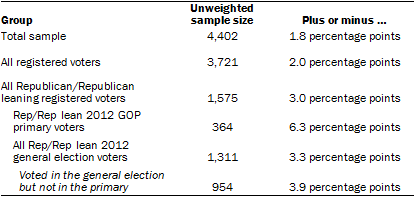The analysis in this report is based on respondents to the Political Polarization and Typology Survey who agreed to join the American Trends Panel (ATP) and were able to be matched to the national voter file (N=4,402). These respondents were originally recruited from the 2014 Political Polarization and Typology Survey, a large (N=10,013) national landline and cellphone random digit dial (RDD) survey conducted January 23rd to March 16th, in English and Spanish. At the end of that survey, respondents were invited to join the Pew Research Center’s American Trends Panel (For more information on the methodology of the American Trends Panel, see: https://www.pewresearch.org/methodology/u-s-survey-research/american-trends-panel/.)
Most of the data in this report is based on the initial 2014 Political Polarization and Typology Survey, though some of the data in this report comes from two follow-up surveys: the April 2014 wave that was conducted March 19-April 29, 2014, and the September 2014 wave that was conducted Sept. 9-Oct. 3, 2014.
This subset of panelists was weighted in a multi-step process that begins with a base weight incorporating the respondents’ original survey selection probability and the fact that some panelists were subsampled for invitation to the panel. Next, an adjustment was made for the fact that the propensity to join the panel varied across different groups in the sample. The final step in the weighting uses an iterative technique that matches gender, age, education, race, Hispanic origin, and region to parameters from the 2012 American Community Survey. Population density is weighted to match the 2010 Decennial Census. Telephone service is weighted to estimates of telephone coverage for 2014 that were projected from the January-June 2013 National Health Interview Survey. It also adjusts for party affiliation using an average of the three most recent Pew Research Center general public telephone surveys as of April, 2014, and for internet use using as a parameter a measure from the 2014 Political Polarization and Typology Survey. Sampling errors and statistical tests of significance take into account the effect of weighting. Interviews are conducted in both English and Spanish, but the Hispanic sample in the American Trends Panel is predominantly native born and English speaking.
Of the ATP panel members, 82.5% were successfully matched to their record in the national voter file. Taking into account the response rate for the 2014 Political Polarization and Typology Survey (10.6%), the cumulative response rate for panelists who matched to the voter file is 4.8%.
All analysis in this report is based on Republican and Republican leaning registered voters who matched to the voter file.
The following table shows the unweighted sample sizes and the error attributable to sampling that would be expected at the 95% level of confidence for different groups in the survey:

Sample sizes and sampling errors for other subgroups are available upon request.
In addition to sampling error, one should bear in mind that question wording and practical difficulties in conducting surveys can introduce error or bias into the findings of opinion polls.
For detailed information about our survey methodology, see https://www.pewresearch.org/methodology/u-s-survey-research/
Voter file matching
The names and addresses of most panelists were gathered as part of the core American Trends Panel methodology and used to match respondents from the survey sample to their corresponding record in a national voter file. The voter file, gathered by TargetSmart from publicly available individual voter lists from each state, contains information on most voters’ turnout history and selected demographic information (note that the voter file does not indicate for which candidate a person voted, only whether they turned out in that election). To match panelists to the voter file, TargetSmart first looked for exact matches using name, address, and demographic characteristics. A second attempt was made with proximity matching, where a radius is drawn around the given address to test slight variations on the match.
Pew Research Center is a nonprofit, tax-exempt 501(c)(3) organization and a subsidiary of The Pew Charitable Trusts, its primary funder.